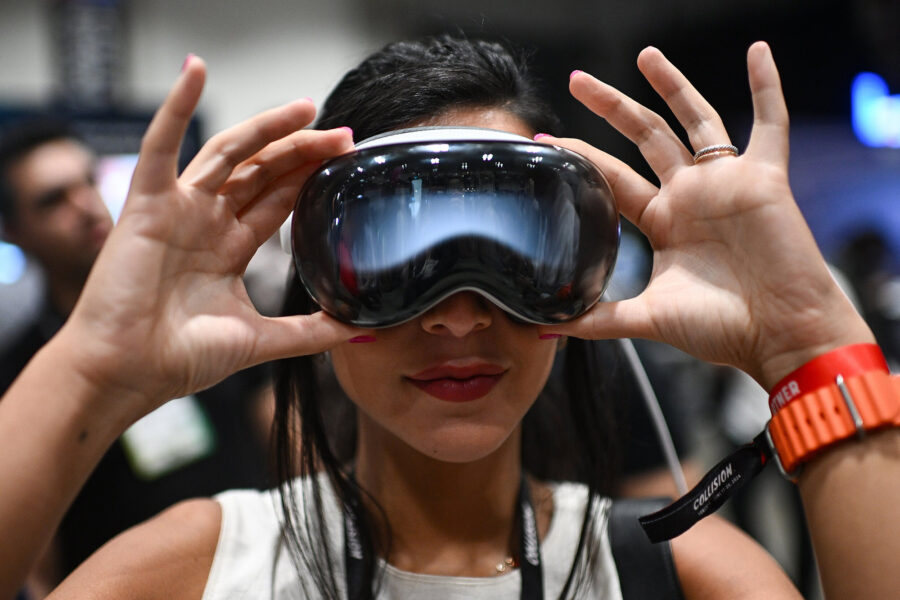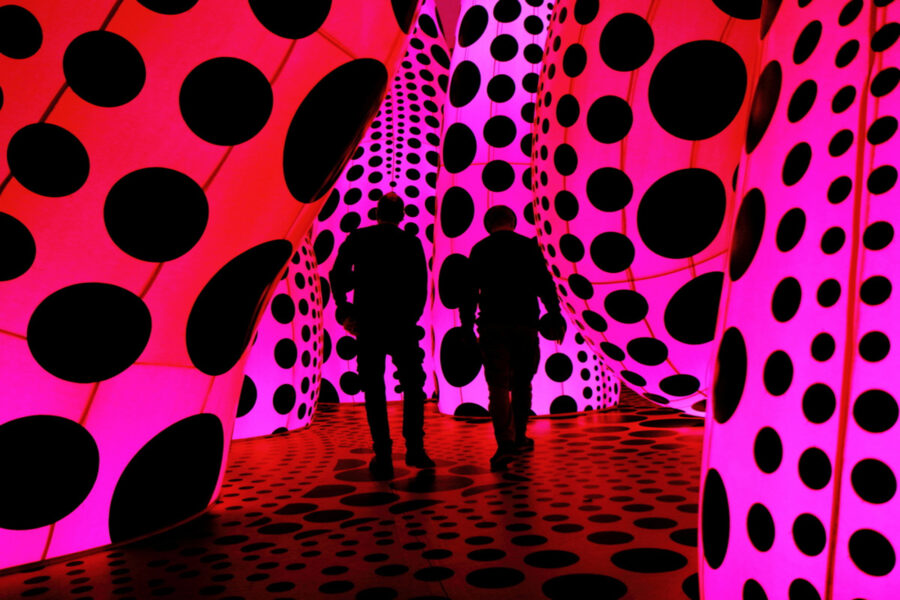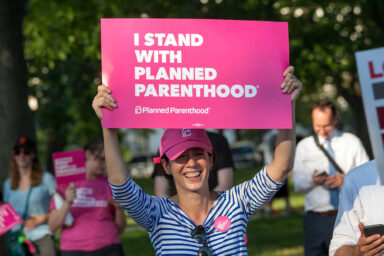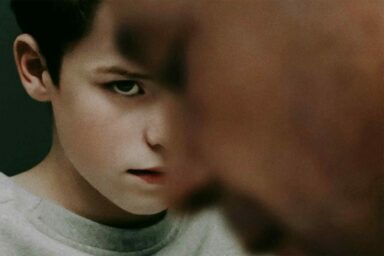Can the great indoor shopping space cure our national loneliness?
|
Listen To This Story
|
Here is a wonderful term that I saw blooming recently in the hothouse of corporate jargon: “executive careabouts.” Ah — exquisite. I say the phrase to myself, executive careabouts, and make the same face a child does when he eats something that he’s recently probed from his nose.
“Executive careabouts” means “things that executives care about.” Executive careabouts is so great because it embodies the kind of insipid, craven, and sycophantic behavior that is typical of jargon generally — adopting the codes of a certain group to perform appropriately for that group’s members and, especially, its elite. These pop-up languages show how desperate we are to be part of a community.
I wondered how Netflix’s conference rooms were lighting up with anxious discussions of executive careabouts before the streaming company announced that it would be opening two “Netflix Houses” in malls in Dallas and King of Prussia, PA. Perhaps you read something about this. A bunch of outlets covered it, producing identical stories that just reworked the press release, which teases up to several of the senses.
Imagine waltzing with your partner to an orchestral cover of a Taylor Swift song on a replica of the Bridgerton set –– and then walking around the corner to compete in the Glass Bridge challenge from Squid Game. After pretending to fight for your life, you’ve worked up an appetite and want to get a bite. …
That fan fever dream will soon become a reality with the opening of Netflix House, an experiential entertainment venue that will bring some of our most beloved titles to life. Building on previous Netflix live experiences for Bridgerton, Money Heist, Stranger Things, Squid Game, and [pop-up restaurant] Netflix Bites, Netflix House will go one step further and create an unforgettable venue to explore your favorite Netflix stories and characters beyond the screen year-round.
In terms of executive careabouts, Netflix wants its “Houses” to extend the experience of beloved IP from screens to “former department store locations” — read: “defunct spaces” — so that consumers can “indulge in retail therapy” in “venues [that] bring our beloved stories to life in new, ever-changing, and unexpected ways.” We have jargon for this, too. It’s called “Disneyland.” (In East Coast dialects, the term is “Disney World.”) Uncle Walt pioneered the immersive fantasy 70 years ago, understanding that it is possible to create underground cultural tunnels connecting movies, TV, rides, toys, real estate, government, a city powered by a nuclear reactor. Someone else’s dream that you can’t wake up from.
What makes these Netflix Houses interesting is how they’re coming along at a complicated time for the whole idea of public space.
Netflix’s audacity in designing a physical venue “to explore your favorite Netflix stories and characters beyond the screen year-round” suggests the company doesn’t have much faith in the near future as a place where our most beloved stories will be rendered in virtual reality.
We have read a lot about how seamless and expansive our world will be when we’re all plugged into a VR space that makes even a fantasia as immersive as Disney’s available without all the inconvenient infrastructure and atomic reactions. As the owner of an Oculus VR headset that is around here somewhere I’m pretty sure, I can verify that this future has not arrived.
As for augmented reality, the closest thing we have that isn’t powerful hallucinogens is Apple’s new Vision Pro. I messed around with one of these a few months ago when my stepbrother brought one to town. The $3,500 ski goggles are pretty impressive: You can see the real world through the lens as you pull up windows to check email or watch a movie. You manipulate these windows by moving your hands around, grabbing and pinching and dragging. After some flailing, I managed to get Mad Max: Fury Road filling the entirety of my vision, end to end.
It’s all satisfying in an expensive way. But it’s also uncomfortably intuitive, as though you’re just remembering an extraordinary skill. By putting on an overpriced hat, you discover you’ve been able to fly by flapping your arms all along.
Still, the cost and the awkwardness of the device are pretty significant obstacles to universal adoption. But I’ll tell you what’s worse. What’s worse is what I saw in a picture taken of my stepbrother on the flight out. There he is, in the aisle seat, happily wearing his Apple Vision Pro. In the picture he’s staring off across the infinite horizon of productivity, and he is of course sliding his virtual windows around by moving his real, human hands with such enthusiasm that he’s very nearly pinching the nipple of the man in the seat next to him.
This is how I learned that one consequence of portable digital universes is the threat of “virtual-spreading,” the unfortunate manipulation of other people’s personal space as it gets swallowed by a user’s immersive sphere. This future, in other words, entails a lot of accidental groping. Which should be a pretty big careabout for everybody.

Perhaps Netflix fears this future, or just recognizes that it’s hard to sell merch through a headset. Whatever the case, Netflix Houses are the company’s attempt to capitalize on the cultural interest in immersive experiences like the sci-fi psychedelia of a Meow Wolf. And launching in bombed-out department stores is a nod to the mall as a major plot point in the third season of Stranger Things. That season inspired, or reflected, a fascination with shopping malls, these curious ruins in the middle of our suburbs. The decay narrative is widespread enough that you can find all kinds of abandoned-mall photo porn online, and that now also has its own jargon: Swedish journalists coined the terms galleriadöden (“mall death”) and spökgalleria (“ghost mall”). Netflix Houses are part of a larger trend of “re-tenanting” dying malls, a phenomenon in which playhouses and escape rooms move into abandoned retail holes.
As a kid of the ’80s, I’d think Netflix was trying to strike fire with wet tinder by resurrecting, of all things, the mall experience.
Here is, to the best of my recollection, every single conversation with my scabby little friends that preceded a trip to the mall:
“What do you want to do?”
“I don’t know. We could go to the mall I guess.”
“Okay.”
Exeunt omnes ad mall
And yet it seems to have left its mark on me. As an adult, every dream I have takes place in a mall. Or a Jungian archetype of a mall — an endless complex of rooms and corridors and spaces that resolve into the shops or bedrooms or airplane cabins that the plot of the dream requires. Sometimes I can remember the specifics of the architecture when I wake up, and I marvel at the vastness and madness of it. (It should be said that I cannot consciously design places like this.) No one would build a space like this in the waking world, and yet it always makes sense in the dream. Of course this is how we would live and work — in these tremendous warrens.
I don’t think it was always this way, this dreaming of infinite spaces. Either I was contaminated by my childhood summers spent in malls or, conversely, malls are just an expression of the collective unconscious.

(I would like to see the artist Yayoi Kusama’s take on the mall. How would she design an infinite Orange Julius?)
But why all the nostalgia? For those of us who grew up in the Late Empire phase of the American shopping mall, this longing seems odd. Keats’s “Ode on a Grecian Urn,” only the ode is to shoplifting fingerless gloves from Spencer’s Gifts.
Is it that we’ve lost what sociologist Ray Oldenburg called “third places” — places that are not home and not work? Oldenburg wrote that we needed third places to meet friends and make friends and just hang out. The passive work of building community. So: coffee shops, bars, parks, gyms, bowling alleys… church if you’re into that sort of thing. I’d only heard about third places in stories lamenting that they are disappearing as a result of the suburbs, the pandemic, and more and more time spent working. Writers connect the “third place gap” to a well-documented crisis of loneliness and isolation.
I have a hard time with the thesis that third places are vanishing. While I don’t doubt the loneliness thing, there does seem to be an awful lot of people congregating in coffee shops and bars. Pickleball is now practically a syncretic religion.
I could be reading the rooms wrong, but are we drawing flawed conclusions? People are having less sex now, but it’s not because of a shortage of genitals. No — if third places and sex suffer, it’s for the same reason: the internet. The internet is the great third place, where you can hang out and where a majority of it is dedicated to sex. It’s a weird third place, though, in that it’s also a first and second place — home and office and an escape from both.
It may only seem like there are fewer places to find community to an increasingly secular, nonimmigrant middle class that spends a lot more time working. We sit in the cafes and bars, we stroll through the parks and browse shops, and we lament the third places. Where are they? we ask. They are everywhere, and yet we are still isolated, even when we’re in them. One can’t help thinking that someone, an executive perhaps, sees in the shopping mall the solution to our loneliness.
So yes, of course, the mall… exactly… the perfect third place… a place to go… just because…
When I was a kid, my friends and I went there to buy a cookie or walk around or try to talk to girls. It was the exhaust of time, this new thing that was left over from a post-industrial transformation. No need to farm, too young for real jobs. Might as well buy. Or no — play-act as though we were buying. To practice for when we had disposable income. Lion cubs wrestle to prepare them for hunting; adolescent American humans go to the mall to teach them how to consume.
That aimless wandering-time, that exhaust-time, that was a “problem” that the internet “solved.” Was it fun? Sure, because I was with my friends, and we were people with such low standards that we also enjoyed hanging out in drainage culverts and on the roof of an elementary school. (Now those were third places.) Running the streets, outside of anyone’s air-conditioned master plan. It was good not because of the mall, in other words. The mall, which, like a lot of other bygone ideas, is jarring to now see resurrected.
So in these unreal times, Netflix’s mall idea is both a cynical corporate cash grab for shares of human attention and a heroic attempt to restore us to physical spaces. Retrograde, regressive, noble. It’s a way of extending escapist fantasies beyond the screen to a place where you can pay to access them. It isn’t a public park, but it’s certainly a way to spend time with other people.
Executive careabouts. Brand activation. Mindshare. Maybe it would be wonderful to live in a world in which Netflix fulfilled Disney’s vision to have a working nuclear reactor. Imagine a shopping mall whose lights stayed on long after the human race was dead and gone!
For now, we have the romance of wandering through a derelict mall like it’s a Roman ruin, dreaming of the glittering fine times when this place was alive with sweatshopped products and white flight. It all seems like a con. A lie the older generation tells the younger about how great it once was. Worse — a lie the older generation tells itself about how great it once was. One more fantasia, one more virtual reality. Yet another place to escape to, because we’re good at finding ways to escape reality while convincing ourselves that if this isn’t how it actually was, it’s how it should have been. Should be.
After I started writing this, I dreamt a few nights ago of a large pack of coyotes emerging from a hedge in what I understood to be my neighborhood. One at a time through a gap in the foliage. There were 12 of them, a large number for urban coyotes, and, as evidence of their success as a pack, they had a camel traveling with them. They all trotted in a line away up the street. Which doesn’t mean anything, of course, the dream, but it was good to get outside again.




